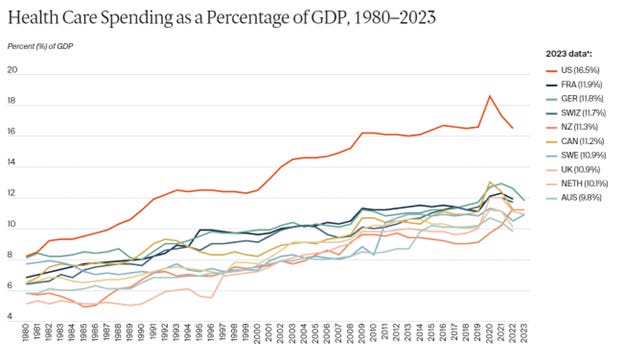Source: Blumenthal, et al Commonwealth Fund, September 19, 2024
The non-profit Commonwealth Fund just released its biennial study of health systems in developed countries, and once again the United States is at the bottom of the rankings for many of the 70 metrics. The US was compared to nine other countries (Australia, Canada, France, Germany, the Netherlands, Sweden, Switzerland, and the United Kingdom). This ranking includes data from surveys of representative panels of adults in each of the 10 countries (completed in 2023) and surveys of primary care physicians in each country (completed in 2022).
The US ranked worst in access to care and health outcomes and was ninth in administrative efficiency. The Commonwealth Fund noted that US health care spending was 16.5% of the GDP (2023); for other countries this ranged from 9.8% (Australia) to 11.9% (France). The US performed well (second to New Zealand) in care delivery process, largely driven by high rates of preventive services. However, they found that US physicians and patients were among the most likely to face hurdles related to insurance rules and billing disputes (second to Switzerland). The US also ranked poorly in terms of health equity, with high rates of differences in care by income and a higher portion of patients reporting that clinicians did not take their concerns seriously due to racial or ethnic background.
Source: Blumenthal, et al Commonwealth Fund, September 19, 2024
Employer implications:
Employers can improve health equity by offering health plans that have robust networks, including diverse providers.
Employers can decrease the financial strain of medical care for lower incomes by including salary banding, where those with lower incomes pay a smaller portion of the total premium. In the WTW 2024 Best Practices in Healthcare Survey, 27% of employers said they structure payroll contributions that reduce costs for targeted groups like low wage employees or certain job classes.
About one in 11 employers (9%) in the 2024 WTW Best Practices Survey report that they structure plan design (deductibles, out-of-pocket maximums and so on) to reduce costs for targeted groups like low wage employees or certain job classes.
Thanks for reading. You can find previous posts in the Employer Coverage archive
Please subscribe, “like” and suggest this newsletter to friends and colleagues. Thanks!
Tuesday: GLP-1 medications shown to improve liver disease




